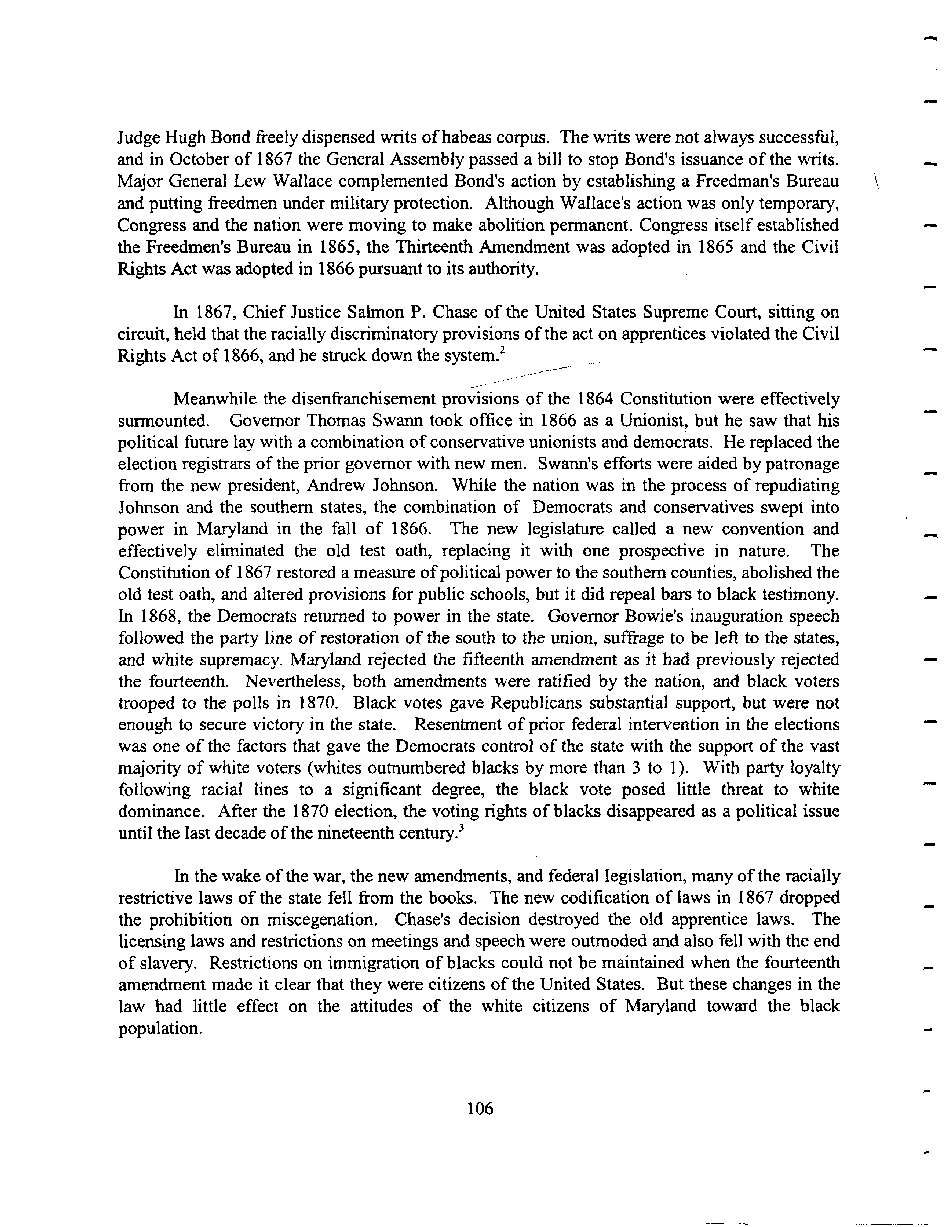|
Judge Hugh Bond freely dispensed writs of habeas corpus. The writs were not always successful,
and in October of 1867 the General Assembly passed a bill to stop Bond's issuance of the writs.
Major General Lew Wallace complemented Bond's action by establishing a Freedman's Bureau
and putting freedmen under military protection. Although Wallace's action was only temporary,
Congress and the nation were moving to make abolition permanent. Congress itself established
the Freedmen's Bureau in 1865, the Thirteenth Amendment was adopted in 1865 and the Civil
Rights Act was adopted in 1866 pursuant to its authority.
In 1867, Chief Justice Salmon P. Chase of the United States Supreme Court, sitting on
circuit, held that the racially discriminatory provisions of the act on apprentices violated the Civil
Rights Act of 1866, and he struck down the system.2
Meanwhile the disenfranchisement provisions of the 1864 Constitution were effectively
surmounted. Governor Thomas Swann took office in 1866 as a Unionist, but he saw that his
political future lay with a combination of conservative unionists and democrats. He replaced the
election registrars of the prior governor with new men. Swann's efforts were aided by patronage
from the new president, Andrew Johnson. While the nation was in the process of repudiating
Johnson and the southern states, the combination of Democrats and conservatives swept into
power in Maryland in the fall of 1866. The new legislature called a new convention and
effectively eliminated the old test oath, replacing it with one prospective in nature. The
Constitution of 1867 restored a measure of political power to the southern counties, abolished the
old test oath, and altered provisions for public schools, but it did repeal bars to black testimony.
In 1868, the Democrats returned to power in the state. Governor Bowie's inauguration speech
followed the party line of restoration of the south to the union, suffrage to be left to the states,
and white supremacy. Maryland rejected the fifteenth amendment as it had previously rejected
the fourteenth. Nevertheless, both amendments were ratified by the nation, and black voters
trooped to the polls in 1870. Black votes gave Republicans substantial support, but were not
enough to secure victory in the state. Resentment of prior federal intervention in the elections
was one of the factors that gave the Democrats control of the state with the support of the vast
majority of white voters (whites outnumbered blacks by more than 3 to 1). With party loyalty
following racial lines to a significant degree, the black vote posed little threat to white
dominance. After the 1870 election, the voting rights of blacks disappeared as a political issue
until the last decade of the nineteenth century.3
In the wake of the war, the new amendments, and federal legislation, many of the racially
restrictive laws of the state fell from the books. The new codification of laws in 1867 dropped
the prohibition on miscegenation. Chase's decision destroyed the old apprentice laws. The
licensing laws and restrictions on meetings and speech were outmoded and also fell with the end
of slavery. Restrictions on immigration of blacks could not be maintained when the fourteenth
amendment made it clear that they were citizens of the United States. But these changes in the
law had little effect on the attitudes of the white citizens of Maryland toward the black
population.
106
�
|

